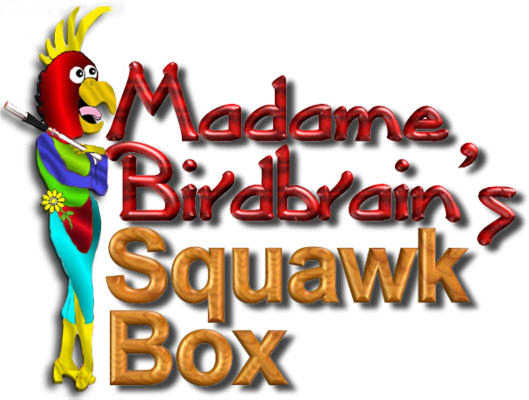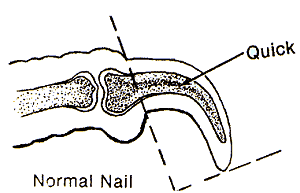 Today's discussion is on nail care. Now ladies, I don't know about you but when I go out in public, I want my nails "just so". You know what an impression that makes on the men.
Today's discussion is on nail care. Now ladies, I don't know about you but when I go out in public, I want my nails "just so". You know what an impression that makes on the men.
I find the easiest and most convenient way to care for birds' nails is to make sure there is some form of lava rock or cement perch in the cage. Birds will take care of their own nails as a rule, if they have the means to do so. By keeping a lava rock or some sort of abrasive material perch within reach, each bird will not only keep their toenails trimmed, but also keep their beak done by rubbing it up and down on the perch during the day.
Also, while we're on the subject of nails, I'd like to go over the procedure for DNA blood sexing. Now, WE KNOW what sex we are, but you know those silly humans just can't tell on some of us since our feathers are the same for both sexes. So let's go over the steps for the humans' sake.
Sample Collection Instructions
Extracting a few drops of blood from your bird can be quick and simple if you follow a few basic instructions. Listed below is a commonly used method for extracting blood from birds. It involves clipping a toenail about two-thirds of the distance from where the nail protrudes out of the toe. This method is quick and simple and presents minimal danger and anxiety to the bird. Remember, there is no age requirement when sexing birds this way in fact, collecting blood samples at an early age may be much more convenient. This method is explained in detail to assure that collection of samples is performed as quickly and accurately as possible. If you are uncomfortable with blood extraction from your bird(s), please consult your local veterinarian for assistance.

Blood Collection from Clipped Toenail
Once you have gained control of your bird, clip a toenail two-thirds of the distance from where the nail protrudes out of the toe. Hold the foot loosely at the ankle to allow the blood to flow freely from the nail. The first few drops of blood that flow from the toenail should be wiped off with a cotton ball or swab. This blood should
NOT be collected because it contains contaminants found in the nail. After the first few drops of blood have been wiped off, place the glass capillary tip end in a blood drop clinging to the nail
(angling the tip horizontally will speed up the capillary action, therefore drawing the blood through the tip faster). The capillary tip have been treated with EDTA to prevent clotting. Once you have successfully filled the capillary tip with the sample, place the entire capillary "filled with blood" into the provided collection tube. Then screw the cap back on the collection tube and gently shake the tube to allow the blood in the capillary to mix with the buffer. After the blood is placed in the collection tube, mark the tube with the appropriate label, matching the sample with the bird. Stopping the blood flow is necessary before returning the bird to it's cage
(Quick Stop or other blood coagulants may help speed up this process). This procedure is best performed with 2 or 3 people.
Previous information provided by Avian BioTech Int'l
Madame Birdbrain loves to get
mail, so if you have a question, or a specific subject you'd like her to cover, please drop her a line. Who knows, the next segment might be for YOU!
Madame's Graphics by
my very special friend, Raubyn
a big THANKYOU!

 Today's discussion is on nail care. Now ladies, I don't know about you but when I go out in public, I want my nails "just so". You know what an impression that makes on the men.
Today's discussion is on nail care. Now ladies, I don't know about you but when I go out in public, I want my nails "just so". You know what an impression that makes on the men. 